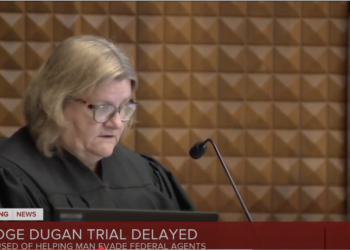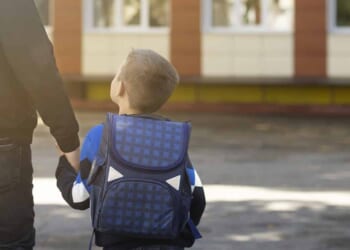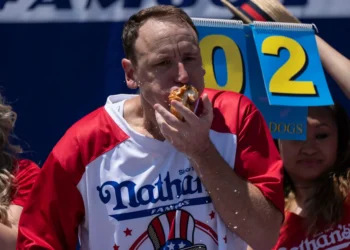July 16 is National Atomic Veterans Day, a poignant day first acknowledged by President Reagan in 1983 and proclaimed annually by President Joe Biden since 2021. Despite its importance, many Americans remain unaware of the experiences of atomic veterans. One of the missions of the new documentary, Atomic Echoes: Untold Stories of World War II, is to educate the public and bridge this gap in awareness.
Atomic Echoes, which premieres Aug. 1 on PBS, follows the personal journeys of two American women who share intimate connections to Hiroshima and Nagasaki, the sites of the atomic bombings on Aug. 6 and 9, 1945. Karin Tanabe’s great-great-uncle, Morito Tatsuo, was the first president of Hiroshima University, while Victoria Kelly’s grandfather, Carmine Gerardi, a medic in the 2nd U.S. Marine Division, was among the more than 67,000 U.S. troops sent to restore order a mere 45 days after the bombings.
These women’s ties, along with their conviction that the U.S. must do a better job of educating the public about the human toll of nuclear weapons, have brought them together in this important project. They embark on personal journeys that connect the past and present, offering unique perspectives on the war and its lasting impact from both sides.
The first part of the film focuses on U.S. atomic veterans who traveled to Hiroshima and Nagasaki in the aftermath of the bombings. While the film includes stark images of the devastation in these cities, it avoids exposing the audience to the most graphic visuals. However, it helps viewers begin to grasp the sheer horror that these atomic veterans experienced.
It’s no surprise that many of these veterans, including Kelly’s grandfather Gerardi, had severe post-traumatic stress disorder (PTSD). As Michas Ohnstad, one of the few surviving atomic veterans, stated in the film, “You can’t escape the sight, the sound, and the smell of the war.”
Additionally, countless atomic veterans have battled numerous health issues caused by radiation exposure. Yet, for decades, their voices were stifled, as they were denied the right to seek medical care or disability compensation from the U.S. government. Due to the Nuclear Radiation and Secrecy Agreements Act, they were prohibited from publicly discussing their experiences, leaving many to suffer in silence.
The government-imposed cover-up has not only affected these veterans’ mental and physical health and access to care but also deeply scarred their relationships with their loved ones. A compelling storyline in the film follows Kelly as she seeks to connect with her grandfather, Gerardi, who died from alcohol poisoning at 42. Through interviews with atomic veterans and her quest to understand a Japanese souvenir he left behind, she explores her family’s legacy.
It’s important to note that the troops sent to Hiroshima and Nagasaki are a part of a larger atomic veterans’ community, which also includes those involved in nuclear tests from 1945 to 1992. The total number of atomic veterans is estimated to be between 400,000 and 500,000.
In 1995, President Clinton issued a formal apology to atomic veterans, and the following year, Congress repealed the Secrecy Act, allowing them to share their stories and apply for Veterans Affairs (V.A.) benefits. Unfortunately, many veterans remained unaware of this until the mid-2000s, and some passed away without receiving the care they needed. The film plays a vital role in preserving history by giving voice to surviving atomic veterans like Archie Moczygemba, who recently turned 101 this July 4, demonstrating that these atomic veterans’ experiences warrant our recognition and support.
But Atomic Echoes goes further than highlighting atomic veterans. By dedicating about a third of the film to the perspectives of Japanese eyewitnesses and survivors, it captures the full impact of these historical events, creating a more powerful narrative that resonates with audiences.
The cinematography of present-day Hiroshima and Nagasaki is captivating. The vibrant images of these cities today serve as a powerful contrast to the haunting historical photographs of the devastation they experienced. This compelling juxtaposition, paired with heartfelt interviews of bombing survivors, powerfully illustrates the extraordinary resilience and desire for peace that defines the Japanese people.
The film commendably humanizes a complex and painful historical event by sharing deeply personal stories, thereby enlightening audiences about the experiences of atomic veterans and Japanese survivors. Kelly and Tanabe’s ties provide an intimate perspective that enriches the overall message of the film.
The film does have a few shortcomings. For instance, Kelly’s quest to find the owner of the Japanese souvenir her grandfather left behind could have been more thoroughly developed, especially considering its dramatic twist. While the filmmakers are keen to showcase the Japanese people’s capacity for forgiveness, they overlook the fact that for some, this process can take time — even after 80 years. This topic deserves a more nuanced exploration.
Additionally, the inclusion of historical footage from Getty Images with its logo still visible is distracting to viewers. While this is a minor issue, it does affect the film’s overall impact.
Despite these flaws, through the testimonies of atomic veterans and Japanese survivors, this film reminds us of the unimaginable suffering caused by these weapons. As we honor our atomic veterans and remember the Japanese atomic survivors, we must commit to preventing nuclear wars in the future.















